HISTORICAL JOURNEYS: Prague, Past and Present

Prague has become a tourist mecca since 1989: its beautiful cityscape conveys its rich history, as Sarah Childs explains in this photo essay.
By Sarah Childs
Prague, the capital of the Czech Republic, has a unique history, which is presented by the city today. It was a part of the Austro-Hungarian Empire but became Czechoslovakia after World War I. Slovakia briefly split from it during World War II but in 1948, after it was reunited, the Soviets invaded and Czechoslovakia became a Soviet satellite state. The Czechs attempted to lessen the control of communism in 1968 during the “Prague Spring,” but Warsaw Pact troops, mostly from Russia, invaded and put down this act of defiance. However, in 1989 the Velvet Revolution occurred that peacefully broke Czechoslovakia away from the rest of the USSR. Then in 1993 the country peacefully split into the Czech Republic and Slovakia.
The Czech Republic’s history can be seen throughout the city and surrounding areas. However, its Soviet history plays a large role in Prague based on the remnants from the area. Some buildings are architecturally different from many of the hundreds of years old buildings and these buildings stand out compared to the rest. The current government, in part housed in historical buildings, shows how the modern Czech Republic incorporates its pre-Soviet history into its modern government. This gives the impression that the country is still actively moving away from Soviet influence. Soviet history is a part of the Czech Republic and its capital of Prague shows this and how it is incorporated into the city, adding to its unique history.
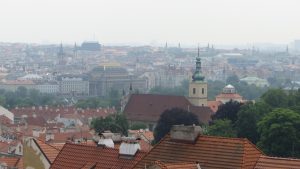
This was taken on the way to Prague Castle. This landscape view of Prague does not show nearly the entire city, but shows how large it is and its architectural diversity.
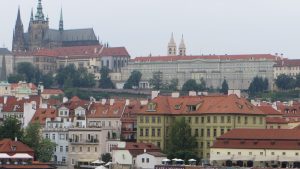
This was taken from the Charles Bridge and shows the Prague Castle. The castle began construction build during King Charles’s IV rule. The Charles Bridge is named after him. Today, the Czech president resides in the castle and surrounding area.
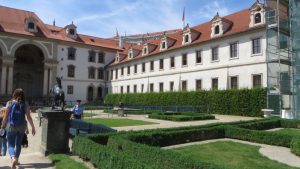
This is the outside of the Czech Senate. The Senate is housed in this historical building surrounded by a large garden area which this picture only shows a small fraction of. The location of the Czech government shows a focus on its pre-Soviet history.
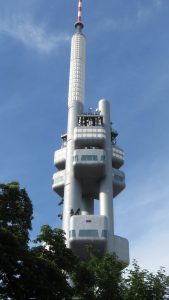
One of the most prevalent Soviet era buildings is the Žižkov Television Tower. It was built between 1985 and 1992, showing that even though the USSR had fallen by the time it was finished and Czechoslovakia broke from the USSR even sooner, the building was still completed. This shows how Soviet influence was prevalent immediately following its collapse and that the country did not try to completely alter its culture to erase Soviet influence. The babies crawling up the side are an art installation by the Czech artist, David Černý.
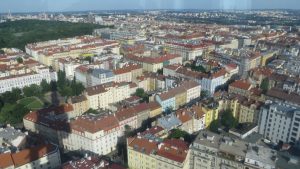
View from the top of the Žižkov Tower, showing Prague’s diverse cityscape.
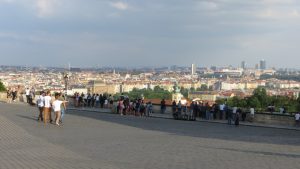
View from near the Prague Castle but with fewer tourists, for Prague has many during the summer. The modern buildings in the background show how the city has modernized to more Western standards following its break from the USSR.
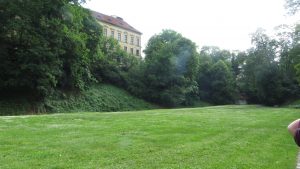
Clearing along a path behind the Prague Castle which used to be a part of the moat. This area is now a park, but during Soviet times it was closed to the public. Its opening to the public today represents that the people enjoy more freedoms to travel within the city, country, and outside of the country, compared to Soviet times.
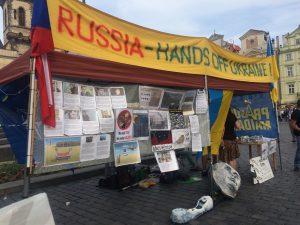
This anti-Russia protest in Old Town Square shows the prevalence of anti-Russian sentiments that continue to exist in the Czech Republic.

View from the Vltava River. Many historical buildings have been preserved, showing their detailed architecture. Soviet architecture was not this intricate.
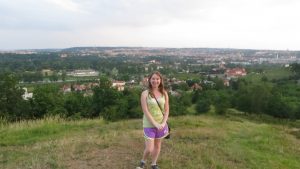
Representing Miami University in Prague! The city is extremely diverse and each part of it shows its unique history. Soviet influence still affects the country, but the city shows that even though Soviet history is recent, Prague represents hundreds of years of history that all influences the country today.
Sarah Childs is a Junior History Major. She studied in Prague in the summer of 2016 through USAC.